Peaceful protests and police violence, hope and fear, courage and apathy – on my trip to Minsk, I encountered the different shades of Belarus in turmoil. While the young generation seems like a guarantee for change, there is a danger that apathy might return to Belarus.
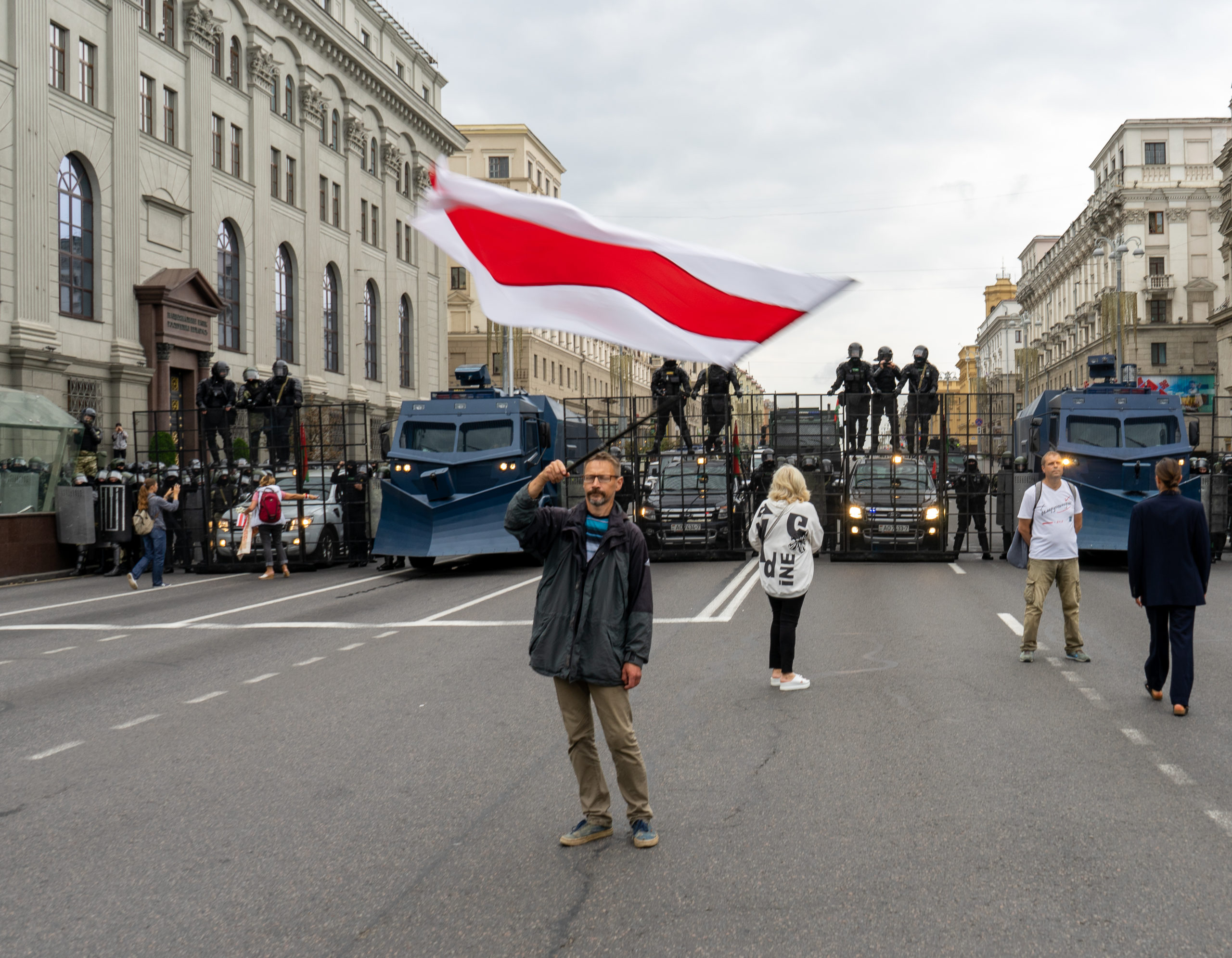
Supermarkets where you could get goods only over the counter, ubiquitous police that suspected you of spying if you took photos of government buildings and portraits of president Lukashenko available in kiosks. When I first visited Belarus in 2006, the country felt a bit like a time travel to the Soviet Union. Most Belarusians were content or apathetic about living in a dictatorship, which had seemingly turned back the clock.
Fast forward 16 years and quiet Minsk has turned into a global hotspot of anti-authoritarian struggle. Images of hundreds of thousands of Belarusians demonstrating can be seen in the news around the world. When a Belarusian friend of mine suggests I come to visit to see these remarkable events with my own eyes, I am at first hesitant. But when the Belarusian embassy in Brussels tells me that there would be no problems to enter the country as a tourist, I book a flight to Minsk.
Still, on arrival, I have to undergo a rather unpleasant 30 minutes interrogation and vetting, but eventually, I am allowed to pass. The airport is eerily empty and silent, and when I sit down in a taxi heading for central Minsk, the driver turns out to be a rabid Lukashenko supporter. He is called Alexey, used to live in Moscow and is convinced that the protestors are all on the payroll of the EU, as the Europeans were eying the Belarusian economy for takeover, presumably after a successful regime change. He also spouts off all the familiar Kremlin propaganda tropes about the decadence of the West from Gayropa (Gay Europe) to raping refugees. “Luckily Putin has already sent his troops to the border with Poland, where they should be”, he laughs knowingly. “We need a strong police to make sure people behave right”.


A new generation as a guarantee for change?
This kind of outspoken support of Lukashenko is relatively hard to come by. The backbone of Lukashenko’s rule was never based on enthusiastic supporters but rather a majority of apathetic people who saw a lesser evil in authoritarian but stable rule, which had largely avoided the massive inequality plaguing other post-Soviet states. Until a few years ago, some of my Belarusian friends defended the dictatorship for lack of alternatives. Many were able to achieve modest prosperity and compared to Russia’s crony capitalism, war in Ukraine and lower standards of living in most other ex-Soviet republics, Belarus seemed to be doing relatively well. A competitive IT sector emerged which created global brands such as Viber or World of Tanks.
When I visited in 2018 and 2019, my tech worker friends showed me a Minsk that seemed technologically advanced, with a modern nightlife and restaurant scene. The long-term dictatorship of a former Soviet collective farmer seemed increasingly anachronistic and most people I talked to were embarrassed about Lukashenko’s frequent gaffes and rustic demeanour. A friend who met the Belarusian president personally to promote her tech company told me that she thought he was hopelessly out of touch and did not really understand their business. The younger generation, often fluent in English, sometimes well-travelled and with a longing for more freedom seemed to be a guarantee for eventual regime change.
People beaten to the point that they lose consciousness
Not unlike in Ukraine in 2013, it was the use of excessive violence against peaceful protesters that mobilised the population, after the rigged election in August 2020. A Belarusian friend who used to defend Lukashenko against Western criticism now said that he had turned “into another Hitler”.
In fact, the brutality of Lukashenko’s security forces in the aftermath of the August 9 election exceeded what has been reported from Russia or Yanukovich’s Ukraine. Several thousand people have been arrested and hundreds of them tortured or beaten. The footage of Omon police frantically clubbing anyone in sight and the images of bodies covered with wounds and bruises went viral around the world.
How it is to suffer from Lukashenko’s police terror, I hear when meeting Vika, a tech worker in her late 20s at my friend’s flat in Minsk. After having spent five days in the infamous Okrestino prison, she is looking for a new place to stay, paranoid about being taken away by Lukashenko’s thugs again. She has been to most of the demonstrations following August 9 and one day, when she left work with her colleagues, out of nowhere, masked security police came running after them, smashed them to the ground and stashed them into a black minivan. She did not know where they were taken, and during her imprisonment, none of her friends or family knew where she was, or what happened to her. She was locked into a cell with four other women with no room for privacy. The light was left on non-stop so they quickly lost any sense of time and they were only allowed to go to the toilet twice a day.
The worst was the psychological terror and threats, which apparently were so horrible, that Vika is unable to talk about it. “I thought I was a strong person…”, she says with tears in her eyes. Some of her male friends were not only exposed to psychological torture: “Do you know what it is like when people are beaten to the point that they lose consciousness?” She asks. She still finds it hard to deal with the trauma and warned me of going to any of the protests. “Now we will become a part of Russia. They will slowly take us over, and the worst thing is that there is absolutely nothing I can do about it”, she remarks with a disheartened gaze.
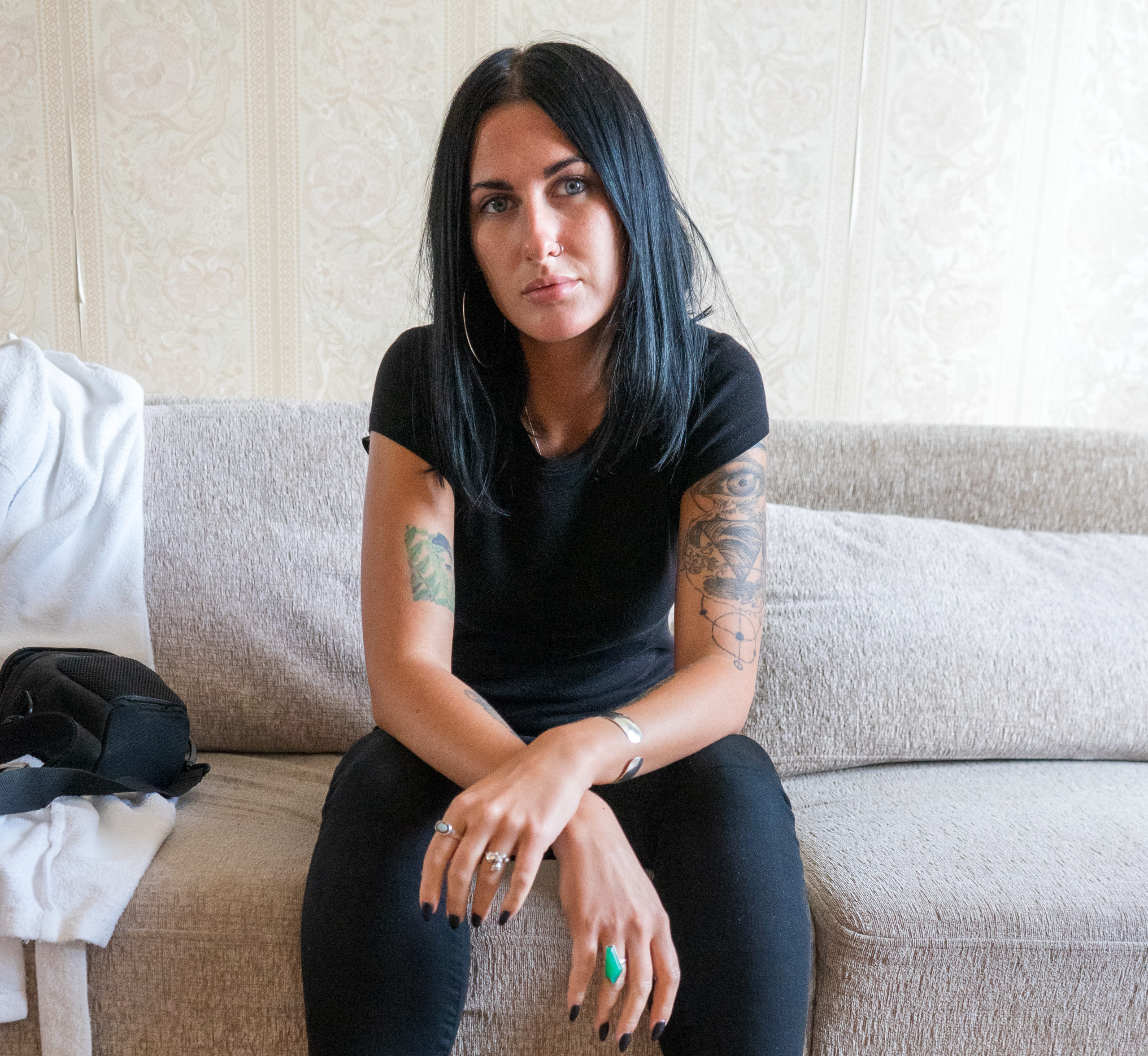

An amazing ambiance of hope and change
A wholly different picture opens up when I meet my friends for dinner and drinks in the city centre of Minsk. Misha, a tech worker, believes that Lukashenko will be gone in a few weeks. And if he stays, he and his wife Veronika plan to move to Germany. Alexey, a Minsk native who lives and works in London came just for the protests. He just prolonged his stay for another week, because ”the ambience of hope and change is so amazing”. And because he wants to support his friends and country in this historic moment.
They are showing me videos of them meeting Maria Kolesnikova the other day. “She is just going out in pubs and random people come up to hug her,” they tell me. Xenia, a young designer tells me: “We just want to live in a normal country without constant threats and violence“. There is a sense of respect and civic responsibility among opposition supporters. People are careful not to drop cigarette butts on the streets, clear away rubbish and insist on not crossing the road with red lights on. It reminds me of Kyiv, where after Maidan people started treating public space more respectfully to show that they cared about the nation in contrast to their corrupt politicians.
Bars are full, people are eating hipster burgers outside in the balmy September night. Everyone listens to Lyapis Trubetskoy, a legendary Belarusian band, whose song “Voini Sveta” was one of the main hits of the Maidan in Kyiv. But many I talk to do not see the Maidan as their role model. Pasha a young university graduate who has been to Lviv recently said that he found the stance of many Ukrainians towards Russia too radical. “We have a common history with Russia, and we were all part of the Soviet Union. So why reject all of that? We just want another government. It is an internal matter. We do not make a choice between Russia and the EU.” When I ask what the EU could possibly do to support the opposition, he cannot really think of anything. We continue bar-hopping until the early morning hours and everything seems almost like a normal Saturday night anywhere in Europe.

Demonstrating as a revolutionary act of freedom
This feeling of normality dissipates when the town fills up with protestors and riot police the next day. My taxi stops shortly before the city centre and when I want to turn right to follow my google maps itinerary, I suddenly find myself in front of a wall of riot police with clubs and shields, blocking an entire 6 lane avenue.
I have to take another route, passing through a side street full of black vans without number plates and masked security forces. With the stories of random and brutal arrests on the streets in the back of my head, it feels very scary to pass by so close. Finally, I meet my friends at the beginning of the protest march which passes a route of about 6 km through central Minsk. Ever larger groups of people in red and white flow along the pavements and finally both sides of the wide Soviet style avenue unite to a powerful stream, which already feels like a revolutionary act.
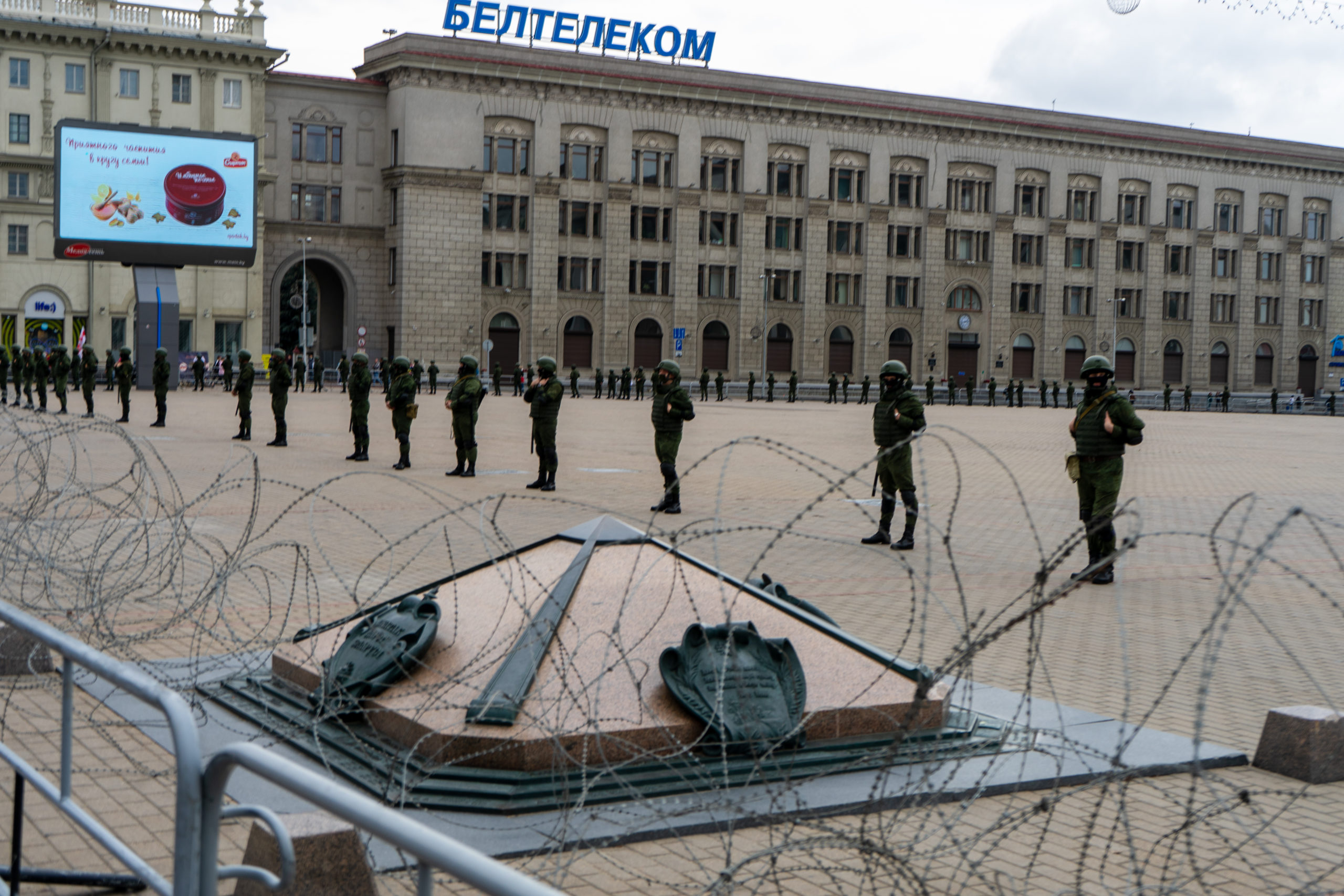

State buildings like the Palace of the Republic are blocked by barbed wire and masked soldiers. Some of them openly film the protesters with video cameras. The message is clear: We have your faces on camera, and you might get punished in the future. Other streets are cordoned off with armed riot police and armoured personnel carriers.


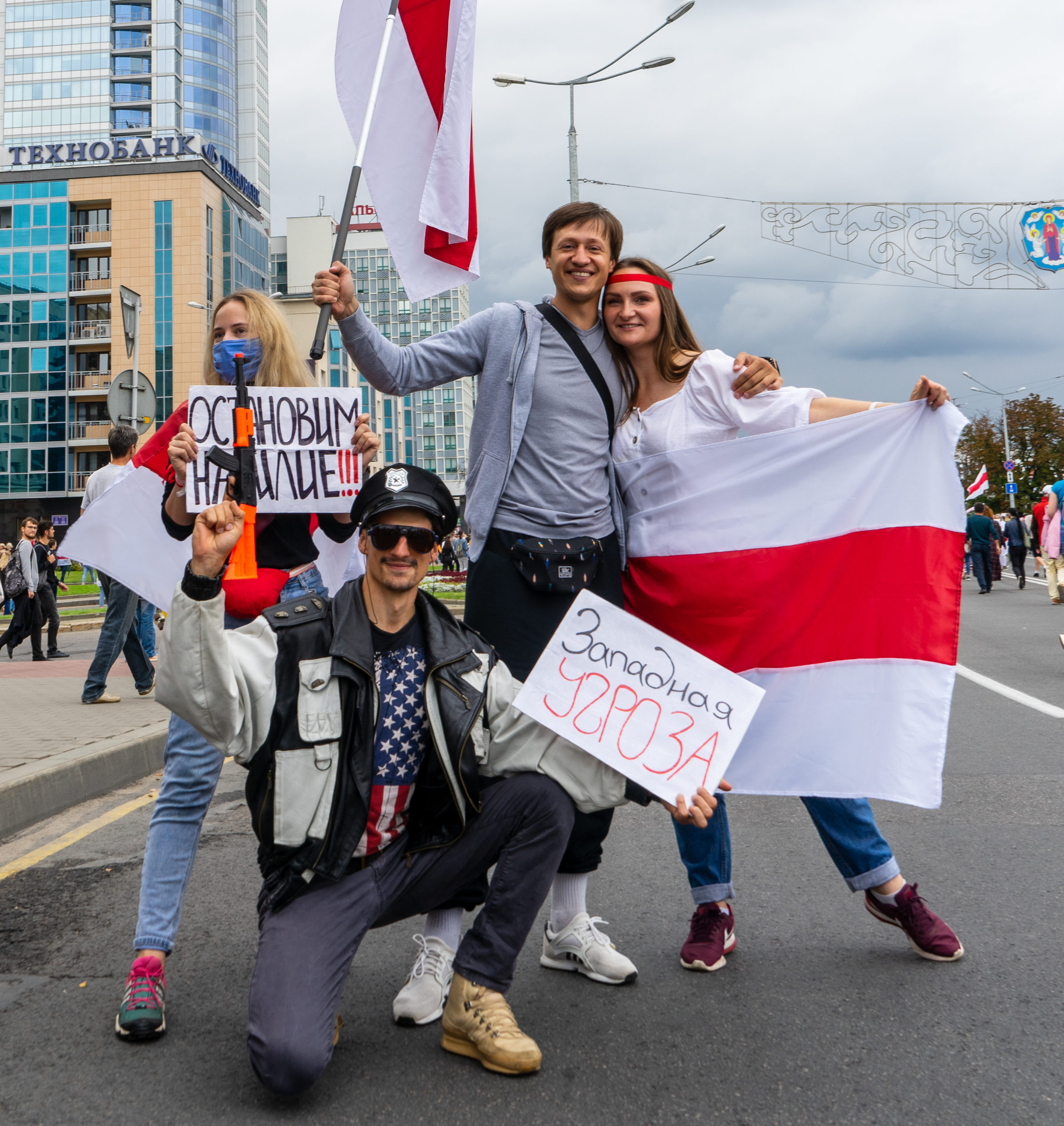

The contrast between the peaceful protesters and this show of brute force could not be larger. The ambience is one of serene elevation with people chanting, flag-waving and sporting placards with creative and often ironic captions. One of the funnier slogans people are chanting is “Sabachku, Sabachku”, which means “little dog, little dog”. They are trolling the pro-regime slogan “za Batku”, meaning “for Batka”, an affectionate nickname of Lukashenko.
There are only Belarusian flags, even a few Russian ones, but unlike on the Ukrainian Maidan, I cannot spot a single European one. Everyone is trying to avoid to add an international, geopolitical dimension to the protests by all means, mainly because of fear of a Russian intervention.
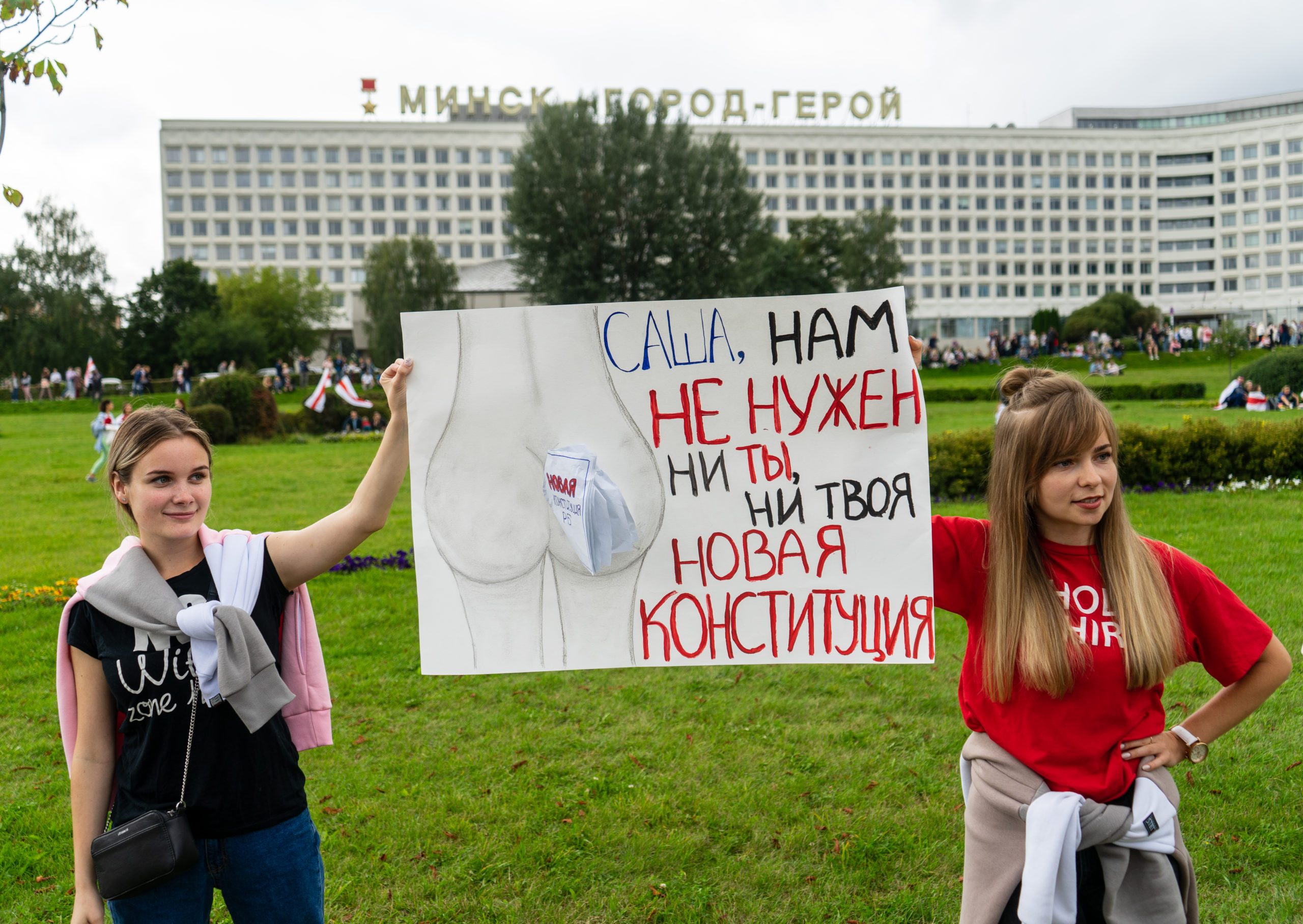



For younger Belarusians going to a protest is a completely new experience, a liberty that did not exist for the last 25 years. Before August, holding a political banner on a public square would land you in a police van within a few minutes. The last larger protests against the fraudulent elections in 2010 and 2006 were brutally broken up very quickly. They were centred on Republic Square, a large plaza similar to the Maidan in Kyiv. The current protests are not fixed to one place, where they can easily be broken up. Organised via the telegram app Nexta, they move like water through the city to avoid a showdown with the police as much as possible. The authorities have shut down the internet during protests, but that has not hindered people from coming. It also means that I have to cling closely to my friends, as it would be hard to find them again without network on the phone.
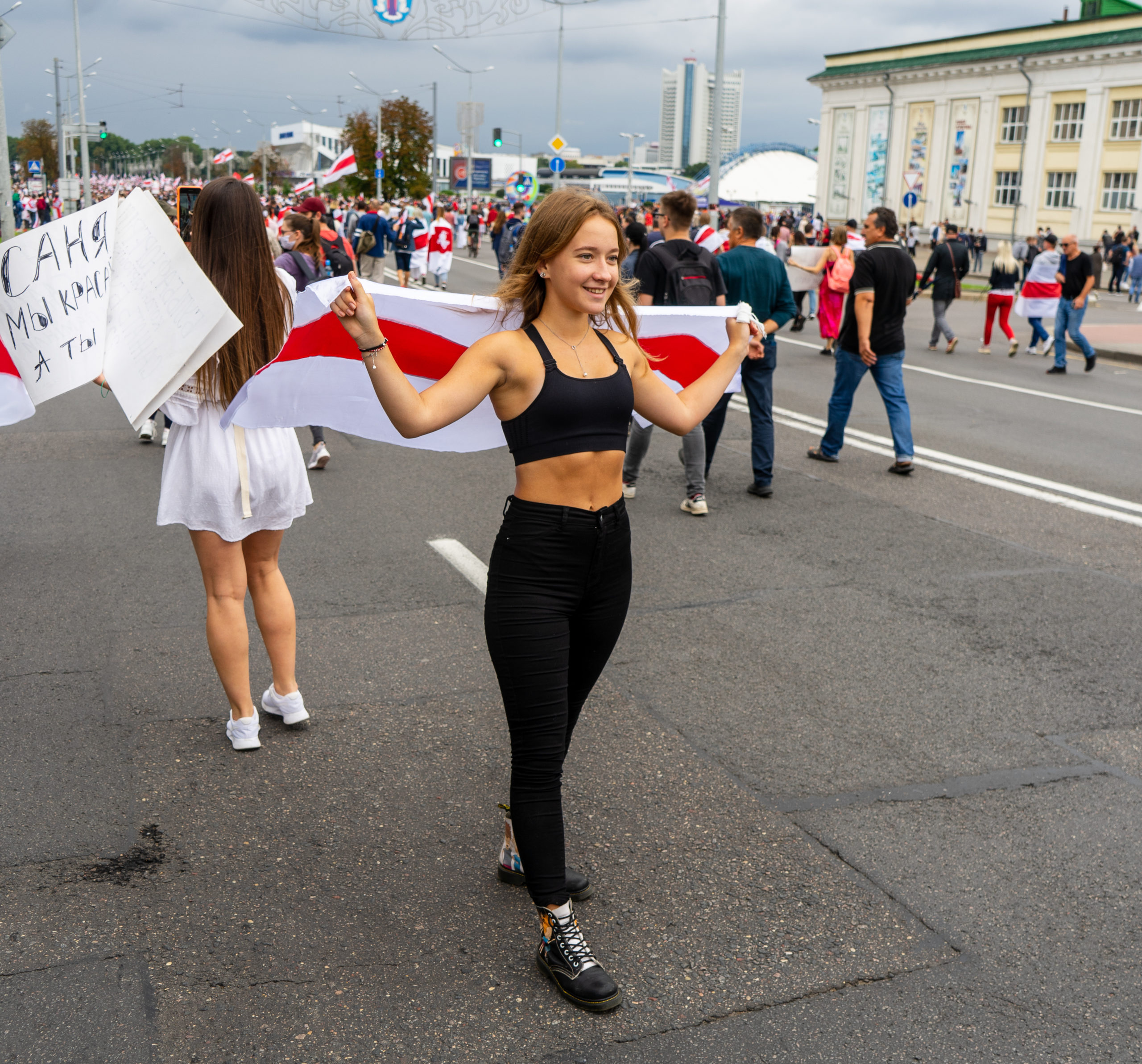
By the time the march reaches the enormous Victory Square, the stream of protestors has become a giant sea of tens of thousands of people. My friends keep reminding me what an unbelievable moment this is. It demonstrates impressively that the majority of people in Minsk are behind the protests, which clearly imparts a feeling of confidence in the crowd. Lukashenko supporters are nowhere to be seen.
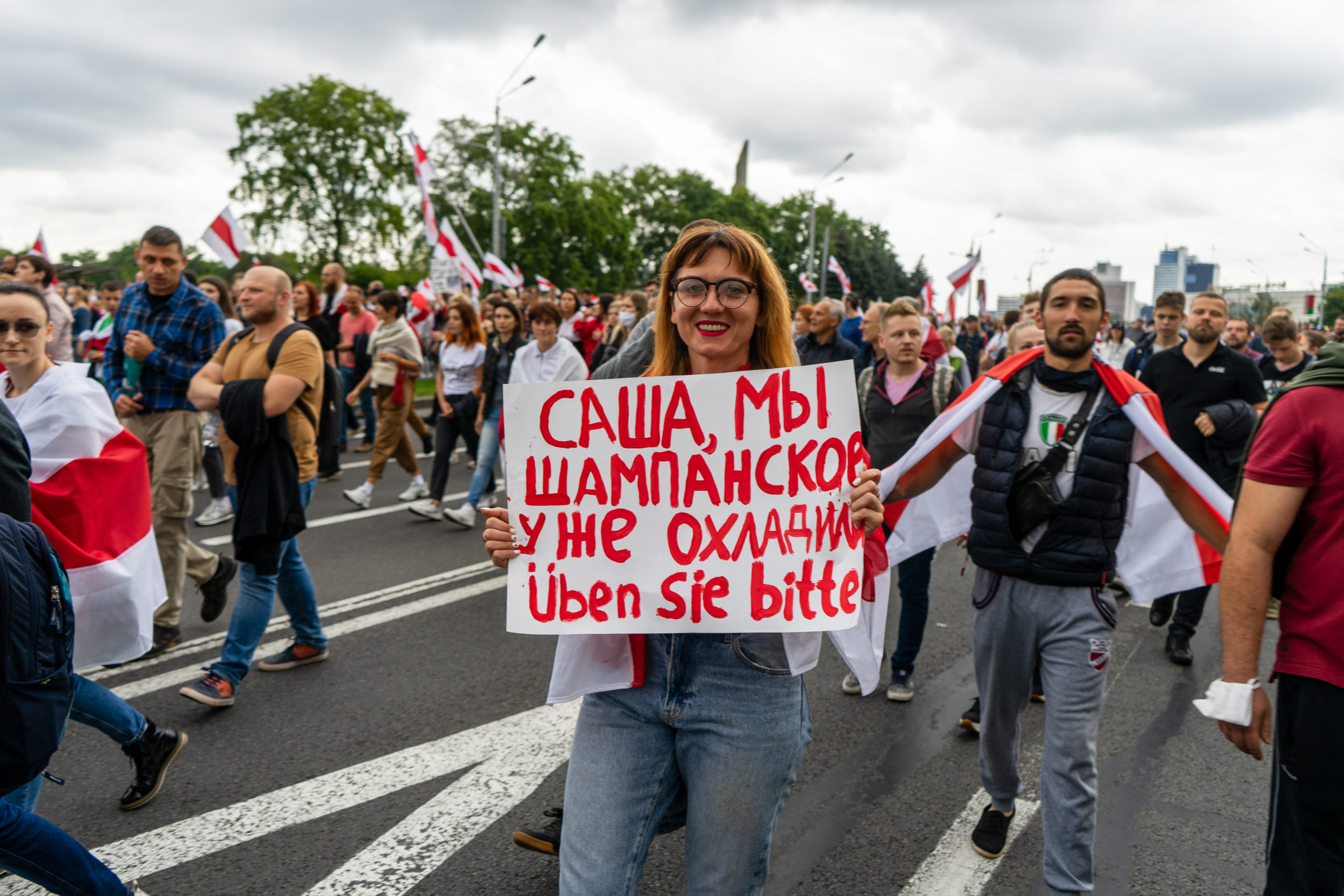

A war of memory and symbols
The stream of people passes by the big World War II memorial and museum, which is heavily guarded, while the authorities are playing old Soviet war songs from speakers to drown the chants of the passing protestors – an attempt of the regime to discredit the opposition in a war of memory and symbols. The regime denounces the opposition colours red and white as a symbol of fascism. Indeed, the BČB as it is called by protesters was used by Belarusian Nazi collaborators, but the flag had already been the official symbol of the independent Belarusian state which existed for a short time in 1918, which had nothing to do with fascism. It was also used by the democratic Belarus that emerged from the USSR in 1991.
Lukashenko reintroduced the old Soviet Belarusian flag in 1994, underlining the shift back to Soviet traditions of authoritarianism but also a state-controlled, arguably fairly egalitarian economy. By playing World War II music, the regime implies: We are upholding the memory of the glorious Soviet victory and protecting the sacred war memorial while the protestors passing by are fascists. Even the sombre opening movement of Shostakovich’s 1942 Leningrad symphony, which is supposed to represent the Nazi invaders, resonates over the enormous Victory Square, making for a bizarre clash of impressions.
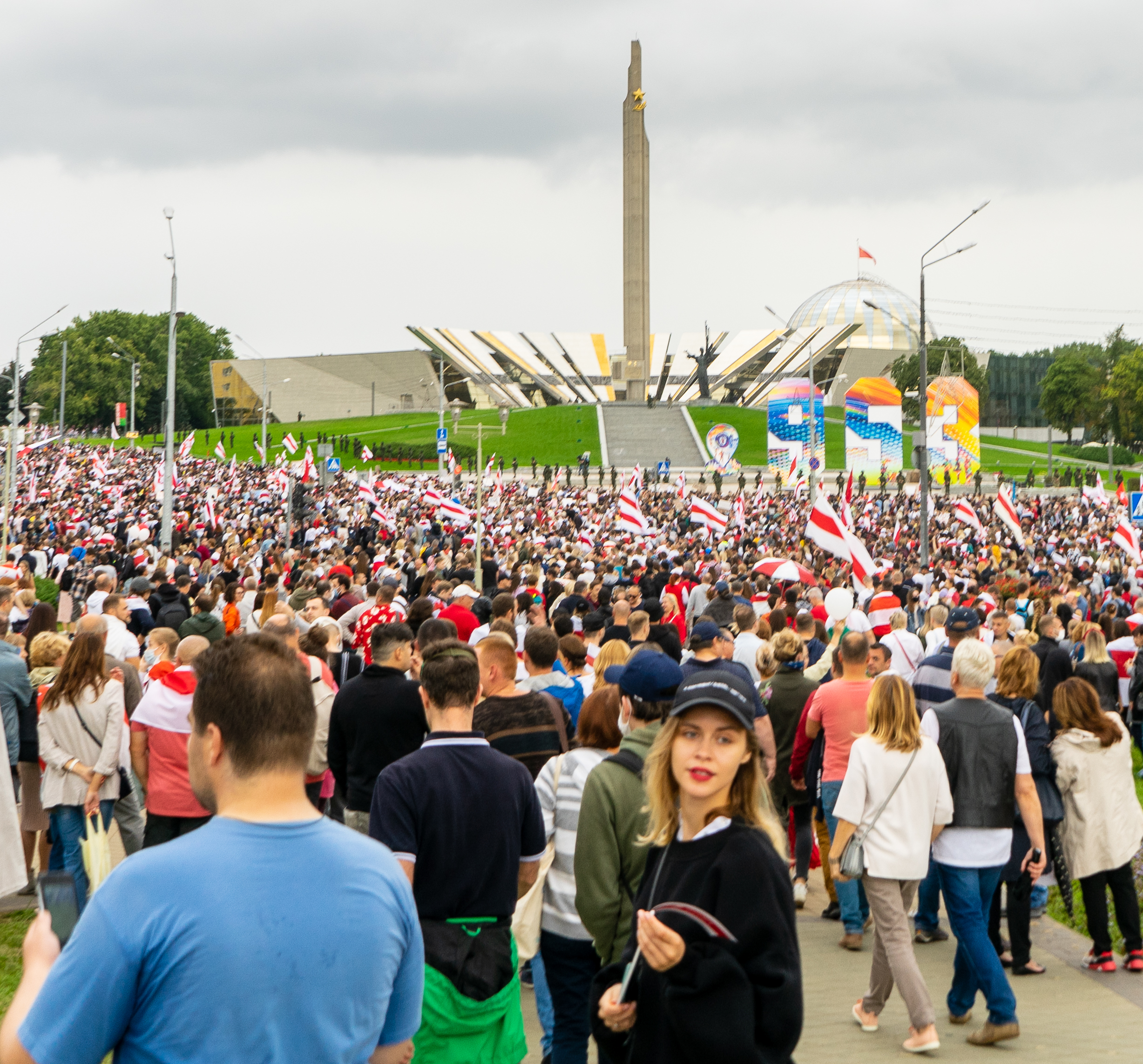

The police starts hunting again
The protest march comes to a halt at a military cordon a few hundred meters in front of Lukashenko’s residence, which looks more like the palace of a Central Asian despot than the seat of a European head of state. It starts raining, but people continue to chant “ukhodi” (go away, or resign), or “go drink tea, Putin is inviting you”, while the silhouettes of what could be snipers can be seen on the roof of the palace. This stalemate between a vast majority of protestors and the dictator hiding in his palace behind the military is symbolic of the overall situation for the past couple of weeks.
The protests continue, but so does Lukashenko’s display of police force and his refusal to listen to popular demands. Shortly after we have left the dissolving protest for a restaurant, the police start their hunt on individual protesters, who are driven away in the ominous black or green vans without number plates. Hours later, with the internet back on, the ugly footage of violent arrests and the pillaging of a café by armed police in civilian clothing goes viral on the telegram channel Nexta. To stay save we take taxis home.
Fear of change and the return of apathy?
When taking the taxi to the airport the next morning, my driver, around 40 years old, reminds me of how Lukashenko might still manage to sit things out. He is against Lukashenko but has concerns about the protest movement that could eventually stick with a large section of Belarusian society. According to him, many of the demonstrators come from the richer parts of society. It is easy for those people to go protest, and continue for longer, he says. They have financial buffers and when the economy suffers or they lose their jobs, they will not suffer so much. Normal workers feel the strain directly and cannot afford prolonged insecurity or a downturn as they immediately have to fight for their very existence.
One of the driver’s clients, apparently a tech entrepreneur and opposition activist, told him that if things became really bad he would just emigrate. “What kind of patriot is that leaving his country behind?” the driver asked. Apparently, the activist had also told him how large state-run enterprises like the automotive producer MAZ, one of the biggest employers of the country should be privatised. The driver fears that this would cost thousands of jobs. According to him, the majority of the population is likely going to suffer if the demonstrations are continuing, no matter the outcome. He does not want Lukashenko to stay in power either but has no idea how he could be replaced. If this kind of thinking becomes more widespread, apathy might return, providing the overdue Lukashenko regime with a renewed lease of life.
When I arrive at the airport the news comes in that Maria Kalesnikova, the last face of the opposition leadership still in Belarus, has been kidnapped. While boarding the plane I have more and more doubts that the protests will be successful in toppling Lukashenko anytime soon. At the same time, I am moved by the courage and hope of the people I have met. I come to the conclusion that the least we can all do, is to keep following the events and keep Belarus on the news and political agenda. The more people are aware and watching, the more the regime will face pressure for its violence.

Kommentare